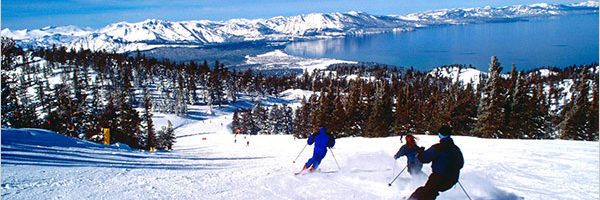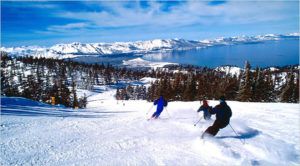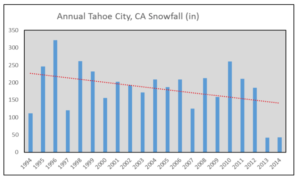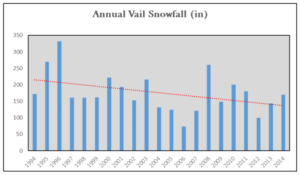When your product is dependent on snow, how do you react to climate change? A look at Vail Resorts.

Vail Resort’s challenges and strategy on reacting to the decreasing snowfall in ski areas due to climate change.
Vail Resorts Inc. is the largest publically owned (NYSE:MTN) ski resort operator in North America. They have 13 premier resorts across Colorado, California, Utah, Minnesota, Michigan, Wisconsin, Australia, and most recently Canada. Additionally, the company has a portfolio of luxury hotels and operates a real estate development arm [1].
Vail Resorts’ business is dependent on the weather in the areas it is located, and therefore climate change is important for the organization to consider. Climate change is proven to have caused increased temperatures around the globe, but is also directly linked to fluctuating rates of rainfall, runoff and evaporation [2]. In particular, global warming has recently caused shifting rainfall patterns around the world and is expected to continue to do so – which is incredibly relevant for Vail Resorts [3].
The impacts of global warming and these decreased precipitation levels are already affecting ski resorts. In two of Vail Resorts key regions: Vail and Tahoe City – annual snowfall in the last 20 years has been trending downward (seen in Table 1 and Table 2) [4].
Table 1: Annual Tahoe City, CA Snowfall Table 2: Annual Vail, CO Snowfall
Source: Donna Bebb, “Climate Exposure Impact on Equity Valuation: Case Study of Vail Resorts, Inc,” Steyer-Taylor Center for Energy Policy and Finance. http://media.law.stanford.edu/organizations/programs-and-centers/steyer-taylor/Vail_Final.pdf, accessed November 2016.
In the last few years, this has become more relevant: California’s resorts have suffered through three years of severe drought from 2012-2014, resulting in annual snowfall less than 60% of average [5]. These changes in snowfall have a direct impact to Vail Resorts’ bottom line. Due to the drought, Vail Resorts experienced at 27.7% decline in their Tahoe resorts skier visitation in their second quarter (Jan. 31) of 2014 as compared to 2013 [6]. Although Vail Resorts does not break out revenue for each resort, they did have to revise their guidance for revenue for 2014 and decreased the guidance from $280-295M [7] to $255-265M [8] directly due to adverse weather in Tahoe.
And we can expect these impacts to continue. A research study in Aspen, another key ski area in Colorado, found that with high climate change scenarios, skiing will likely not be possible in Aspen in 2100, while low scenarios hold that skiing may be preserved only in high elevations. It is expected that the ski season will be shortened and snow depths will be reduced by 2100 [9].
Vail Resorts has already begun to take measures to address climate change and protect their core winter business. First, anticipating lower snowfall levels, Vail has begun to further invest in snow-making equipment in order to entice skier visits [10]. Unfortunately, these snow making machines will require a growing amount of energy use as global temperature increases, which makes this solution unviable in the long term.
Additionally, in order to support and maintain their winter revenue, Vail Resorts has geographically diversified their portfolio of resorts – so that poor weather will not impact all of their resorts at the same time. For example, Vail recently acquired Whistler-Blackcomb, a large ski resort in British Columbia, Canada which is in a different mountain range and weather region than Vail’s other key resorts [11].
Vail resorts has also expanded its off-season mountain activities to explore other revenue opportunities. This past summer they launched “Epic Discovery” at Vail and Heavenly, which is an adventure center (e.g., zipline, water park) on the mountain [12]. Despite this effort to expand services, winter quarters still generate 100% of profit [13].
Finally, Vail Mountain Resorts has also focused on energy efficiency and renewable energy. They reduced 10% of their energy use, and also have invested in a few small renewable energy projects in Colorado with solar panels [14].
Although Vail is actively taking steps to mitigate against climate change – more can be done. First, they need to re-brand and refocus as an outdoors resort not as a ski resort. Vail will be unable to maintain their core winter revenue in the future and needs to shift and prioritize to year-round mountain activities as soon as possible. They should offer year-round activities such as guide-led hiking and backpacking adventures, outdoor movies, campfires, and kids camps. It is critical that they make this key business move now and build other revenue lines, versus later when their business is in decline.
To follow their rebranding as a full outdoors experience, Vail Resorts needs to focus deeply on being environmentally sustainable and being a leader as a fully sustainable resort. This would include being fully supported by renewable energy sources, focusing on water conservation, reuse and educate their visitors on these elements of environmental sustainability. (765)
Endnotes:
[1] Vail Resorts Inc, “Company Profile,” http://www.vailresorts.com/Corp/info/company-profile.aspx
[2] John Carey, “Global Warming and the Science of Extreme Weather,” Scientific American, June 29, 2011, https://www.scientificamerican.com/article/global-warming-and-the-science-of-extreme-weather/
[3] Kate Marvel and Celine Bonfils, “Identifying External Influences on Global Precipitation,” Proceeding of the National Academy of Science of the United States of America, October 18, 2013, http://www.pnas.org/content/110/48/19301.full
[4] Donna Bebb, “Climate Exposure Impact on Equity Valuation: Case Study of Vail Resorts, Inc,” Steyer-Taylor Center for Energy Policy and Finance. http://media.law.stanford.edu/organizations/programs-and-centers/steyer-taylor/Vail_Final.pdf, accessed November 2016.
[5] Ibid.
[6] Vail Resorts Inc, “Vail Resorts Reports Fiscal 2014 Second Quarter Results and Increases Quarterly Dividend 100%,” http://investors.vailresorts.com/releasedetail.cfm?ReleaseID=832299
[7] Vail Resorts Inc, 2014 First Quarter Results, http://files.shareholder.com/downloads/MTN/3138243372x0x712501/1DEA0C71-44D1-4C86-9977-48282A53B6A4/MTN_News_2013_12_9_General_Releases.pdf, accessed November 2016.
[8] Vail Resorts Inc, 2014 Second Quarter Results, http://investors.vailresorts.com/releasedetail.cfm?ReleaseID=832299, accessed November 2016.
[9] Aspen Global Change Institute, “Climate Change and Aspen: An Assessment of Impacts and Potential Responses.” http://aspenpitkin.com/Portals/0/docs/City/GreenInitiatives/Canary/2006_CCA.pdf, accessed November 2016.
[10] Donna Bebb, “Climate Exposure Impact on Equity Valuation: Case Study of Vail Resorts, Inc,” Steyer-Taylor Center for Energy Policy and Finance. http://media.law.stanford.edu/organizations/programs-and-centers/steyer-taylor/Vail_Final.pdf, accessed November 2016.
[11] Allen Best, “Climate Change a Factor in Vail Resorts Swallowing Whistler,” Mountain Town News, August 12, 2016, http://mountaintownnews.net/2016/08/12/climate-change-a-component-of-vail-resorts-swallowing-whistler/, accessed November 2016.
[12] Heavenly Resort, “Epic Discovery”, http://www.skiheavenly.com/info/epic-discovery.aspx#/TheAdventurePass, accessed November 2016.
[13] Donna Bebb, “Climate Exposure Impact on Equity Valuation: Case Study of Vail Resorts, Inc,” Steyer-Taylor Center for Energy Policy and Finance. http://media.law.stanford.edu/organizations/programs-and-centers/steyer-taylor/Vail_Final.pdf, accessed November 2016.
[14] Vail Resorts, “Renewable Energy”, http://www.vailresorts.com/Corp/info/powered-by-wind.aspx, accessed November 2016.






This is a well written and thoughtful blog post about Vail Ski Resorts and the difficulties that they will face in the future due to climate change. Thank you, Margaret.
An interesting parallel to your post on Vail that can be drawn is what Russia did for the Sochi winter Olympics in 2014. As this article states, (http://www.theverge.com/2014/2/4/5377356/sochi-winter-olympics-2014-subtropical-transformation), Sochi is a subtropical resort by the Black Sea with an average temperature of 52 degrees in the winter. Though the area is picturesque, it is not an obvious, or easy place for Russia to have chosen to host the winter Olympics. Due to its geography, when February rolled around and the winter Olympics were about to begin, there was not enough snow for many of the sports to be able to effectively compete and so Russia had to go into crisis mode.
As mentioned in your post, Russia had to start producing snow that they would transport up the mountain to cover the slopes in order to have the appropriate landscaping for the Games to be run. Interestingly, Russia was not the only country where this happened, the 2010 winter Olympics in Vancouver experienced a similar issue, “buckets of snow had to be airlifted to top up the slushy covering on the hay bales that were being used to create artificial mounds in the tracks.” (Ibid).
The 2020 winter Olympics are to be held in Beijing which is quite controversial for two reasons, 1). Beijing will become the first city to host the summer and the winter Olympics, and 2). there is now IOC has decided that being in a mountainous region that produces snow is irrelevant and the winter Olympics will start to be hosted in a more diverse set of locations where the snow for the events is all pumped in. As the BBC writes, “It’s a sad day when the International Olympic Committee cannot even clear one of the lowest bars for choosing the host city for the Winter Games: snow”. (http://www.bbc.com/sport/winter-sports/33747313)
Interesting piece. As a recreational skiier and lover of the outdoors, this thoughtful breakdown of the precarious position of Vail, and many of its peer resorts, resonates with me. The component I’m most skeptical of is their ability to realize substantial non-ski revenue. I don’t understand why Vail would be a materially more attractive hiking / outdoors destination compared to the many free- or low-cost park lands and competing mountains in Nevada / Colorado, etc. As a result, I wouldn’t rush to making investments in attempt to attract summer/spring/fall outdoors visitors. Instead, I suspect Vail will either need to expand geographically (as you outlined) or get creative with cost cutting measures if it is going to stay viable in its historic footprint.
Nice piece, Margaret! Now I’ll be more appreciative when I get to ski on real snow. One thing that stands out is how ski resorts are harmed by climate, but not necessarily responsible for climate change, further highlighting one of the biggest incentive issues for the topic in general.
I like how your next steps focus on both how Vail can become sustainable, by focusing on energy efficiency and renewable energy, but also keep the business in mind, by suggesting that they use their assets (land, lodging, dining) to re-brand and focus on year-round activities. I’m impressed that they have started making decisions, such as acquiring Whistler-Blackcomb in Canada, that take into climate change. Perhaps even without climate change, this would have been a wise investment, but I think that more companies should be thinking ahead in this way.
As a recreational skiier, I really enjoyed reading your post. Your piece was particularly salient given that I haven’t been able to ski in Vermont around Christmas for the past two years due to temperatures above 50F degrees and we’re about to head into winter and ski season.
I agree with your suggestion that Vail resorts should diversify its activity offerings by leveraging year round opportunities (and I respectfully disagree with RC). Vail is “sexy” — families want to go there year round. To that end, Vail can (and should) capture this value for its shareholders. It will also ensure that revenues remain steady during warmer years when the winter months aren’t conducive to skiing.
You allude to another interesting point: there is a vicious cycle occurring right now. As temperatures increase, Vail must produce most snow, which isn’t a sustainable business practice. However, there is little incentive fro Vail to stop producing snow and adopt more sustainable practices, given the free rider problem inherent in climate change. If Vail invests in cleaner technology and reduces its carbon footprint, temperatures aren’t going to stop rising. Therefore, they may not benefit from the upfront investment in clean practices — so is it worth the investment? It seems like a Catch22 to me…
As an avid snowboarder, I think about this issue a lot. I wonder if virtual reality can play a role here. Perhaps we can create a way for people to experience the thrills of flying down a mountain head first on two pieces of carbon fiber without further exacerbating our carbon footprint. I understand that this doesn’t solve Vails problem; in fact, it might even take business away from them if people are able to “ski” from the comforts of their own home. But, I think it would be in Vail’s best interest to consider ALL alternatives given that skiable snow may be non-existent in 2100.